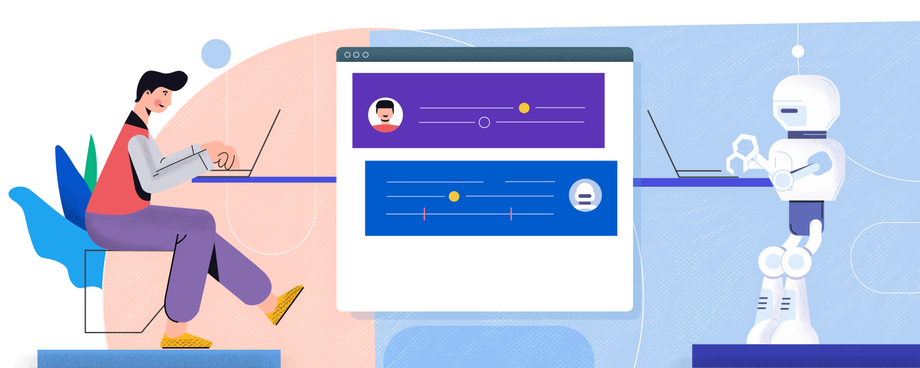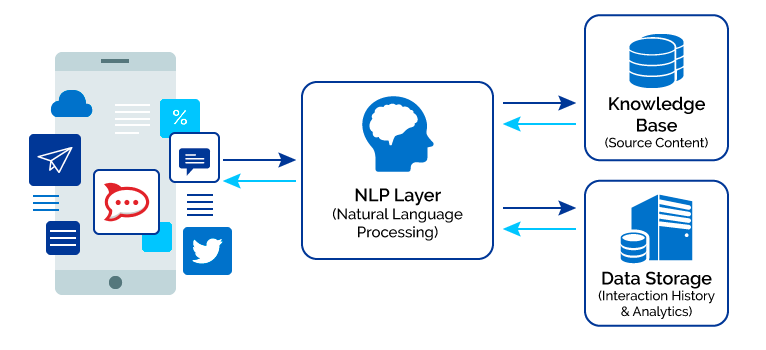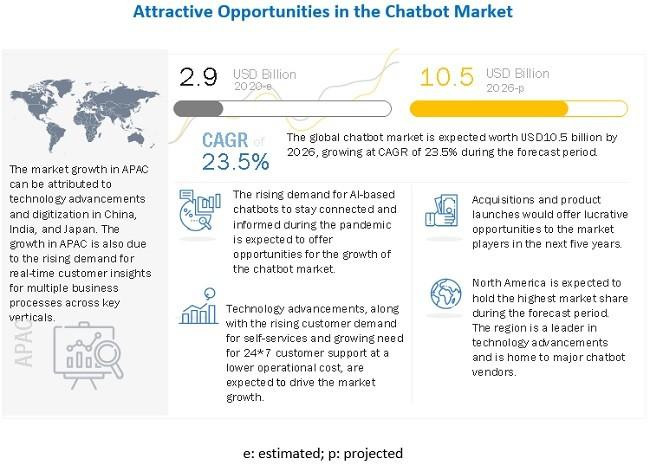Recently, new tools designed to simplify the interaction between humans and computers have hit the market: Chatbots and virtual assistants are some of the industry’s newest tools designed to simplify the interaction between humans and computers.
What exactly is a chatbot?
A chatbot is defined as an AI-based computer that simulates human interaction. They are also known as digital assistants that understand human capabilities. Bots interpret and process the user request and give prompt relevant answers.
Bots can through voice as well as text can be deployed across website, applications and messaging channels such as Facebook Messenger, Twitter, WhatsApp, etc.
Now let's have a look at how chatbots work and their types.
A chatbot is artificial intelligence (AI) software that can simulate a conversation (or a chat) a user in natural language through messaging applications, websites, mobile apps or through the telephone.
Why are chatbots important?
A chatbot is often described as one the most advanced and promising expressions of interaction between humans and machines. However from the technical point of view a chatbot only represents the natural evolution of a Question Answering system leveraging Natural Language Processing (NLP). Formulating responses to questions in natural language is one of the most typical Examples of Natural Language Processing applied in various enterprises’ end-use applications.
How does a chatbot work and their types?
There are two different task as the core of the chatbot:
- User request analysis
- Returning the responses
How a Chatbot Works: As you can see in this graphic, a chatbot returns a response based on input from a user. This process may look simple; in practice, things are quite complex.
User Request Analysis:
This is the first task that a chatbot performs. It analyzes the user’s request to identify the user intent and to extract relevant entities.
The ability to identify the user’s intent and extract data and relevant entities contained in the user’s request is the first condition and the most relevant step at the core of a chatbot: If you are not able to correctly understand the user’s request, you won’t be able to provide the correct answer.
Returning the Response:
Once the user’s intent has been identified, the chatbot must provide the most appropriate response for the user’s request. A chatbot is programmed to work independently from a human operator. It can answer questions formulated to it in natural language and respond like a real person. It provides responses based on a combination of predefined scripts and machine learning applications. The answer may be:
- a generic and predefined text;
- a text retrieved from a knowledge base that contains different answers;
- a contextualized piece of information based on data the user has provided;
- data stored in enterprise systems;
- the result of an action that the chatbot performed by interacting with one or more backend application; or,
- a disambiguating question that helps the chatbot to correctly understand the user’s request.
Now the question is How does the chatbot can help you during lockdown?
As COVID-19 imposed social/physical distancing on business and individuals alike, businesses are looking for Digital solutions that enable contactless commerce and remote work operation amidst this Global pandemic. Chatbots are the answers to many challenges forced by pandemic, from social distancing to increase volume of customer/employee queries to remote working.
Immense value to businesses not only in service quality delivering it scale and speed. In the current covid-19 pandemic, businesses across industries and using them in a variety of ways to help other employees, customers, clients, partners, vendors and other stakeholders I am listening out for some popular use cases where chatbots can help during covid-19.
- Telemedicine;
- Virtual Appraisals;
- Order Health supplies:
- Return to work Guidelines/Checklists;
- IT Helpdesk;
- Human Resource;
- Customer Services.
According to industry experts, routine jobs which require lesser human skills have been witnessing a takeover by machines with artificial intelligence (AI), industrial robots, service robots, and robotic process automation (RPA) playing an active role.
As the world emerges from the grip of the pandemic, business leaders in sectors, including manufacturing and retail, will look to bring their supply chains closer to key markets. This will cause a move toward greater global diversification and technology-enabled demand responsiveness using big data, AI, and cloud technologies," noted technology research firm Forrester in a recent report.
Automation adoption across the business process management sector has been the highest over the past 4-5 years both for customers and internal efficiency initiatives. Automation comes with costs so businesses were walking the line between efficiency and cost which at the Indian wage rates was still possible, said Leslie Joseph, principal analyst, Forrester.
However, with the effect of the pandemic unlikely to wear off soon and availability of human workforce likely to be stretched, companies may now be forced to automate faster.
On an immediate basis, businesses are likely to migrate to simpler solutions such as chatbots and backend processing automation solutions which are less capital intensive than large scale industrial automation. But in the long run,experts feel more critical human functions are likely to go to the machines.
How chatbots can help reduce customer service costs by 30%
The chatbot market is estimated to witness a trivial slowdown in 2020 due to the global lockdown. The pandemic has increased the churn rate and shuddered almost every industry. The lockdown is impacting global manufacturing, and supply chains and logistics as the continuity of operations for various sectors is badly impacted.
The sectors facing the greatest drawbacks are manufacturing, transportation & logistics, and retail & consumer goods. The availability of essential items is impacted due to the lack of manpower to work on production lines, supply chains, and transportation, although the essential items are exempted from the lockdown.
The condition is expected to come under control by early 2021, while the demand for chatbot solutions and services is expected to increase due to the increasing demand for enhancing customer experience and building a personalized relationship with prospects. Several verticals would deploy a diverse array of chatbot solutions and services to enable digital transformation initiatives, which address mission-critical processes, improve operations, and differentiate customer viewing experiences.
The reduction in operational costs, better customer experiences, resolution of customer queries, enhanced visibility into processes and operations, and improved real-time decision-making are key business and operational priorities that are expected to drive the adoption of chatbots.
Better customer service experiences, at a lower cost
265 billion customer support requests are made every year, and it costs businesses a whopping $1.3 trillion to service them. Chatbots can reduce these costs significantly when companies upgrade from antiquated, inefficient IVR technology to AI, chatbots, virtual assistants, messaging and other new technologies that are already helping transform call centers across the world.
According to Chatbots Magazine, businesses can reduce customer service costs by up to 30% by implementing conversational solutions like virtual agents and chatbots.
Freeing up human agents at contact centers to address complex inquiries allows representatives to take their time and provide better service. It also reduces the number of agents required on the call center floor as well as employee attrition due to the repetitive nature of routine calls. All of these lead to significant cost savings. According to this QATC report, call center attrition rates are twice the average of all other industries combined (30% – 45% compared to the U.S. average of 15%).
Staffing a 24x7x365 contact center mainly with human agents can be costly, as can contracting a BPO contact center provider. When you add the resources required to support multiple lines of business and languages, it increases the headcount and skill sets required to serve customers around the clock.
For companies like Autodesk, about half of the customer support calls they receive are for routine requests that can be resolved fairly quickly. The virtual assistant acts as the first line
of defense and only more complex inquiries can be escalated to human agents. Even if a call is escalated to a human agent, the chatbot “stands by” on the call for:
– Continuity and conversation wrap up and documentation;
– In case there are human/machine learning opportunities;
– If simple tasks like payment card or contact information changes need to be completed.
Make customer service easy, because losing customers is expensive
Statistics from contact center software provider Aspect Software estimate that the average cost of a customer service phone interaction is around $35 to $50 per interaction. Text chat, by comparison, is significantly less expensive, averaging around $8 to $10 per session. In the healthcare and banking sectors, the Juniper Research study found that interaction costs can also be lowered significantly, by an estimated 70 cents per interaction by 2022 with chatbot automation. Studies show that it’s realistic to aim to deflect between 40% – 80% of common customer service inquiries to chatbots.
Customers, especially millennials, are increasingly turning away from calling for support and opting for messaging and other self-service channels.
According to a Deloitte study, 56% of companies in the multimedia and technology industries are planning to invest in contact center AI in the near future. They interviewed executives from over 450 cross-industry contact centers, and 33% said they planned on investing in AI chatbots for customer service in the near future. The highest priority for these investments would be to improve cross-channel experiences.
Only 2% of those dissatisfied customers will reach out to the contact center to complain, but you can imagine that many of them will tell their friends and family about their poor online experience. Add the cost of a damaged reputation to a loss of $240 million in annual sales, and you have a recipe for serious erosion of market share and shareholder confidence.



